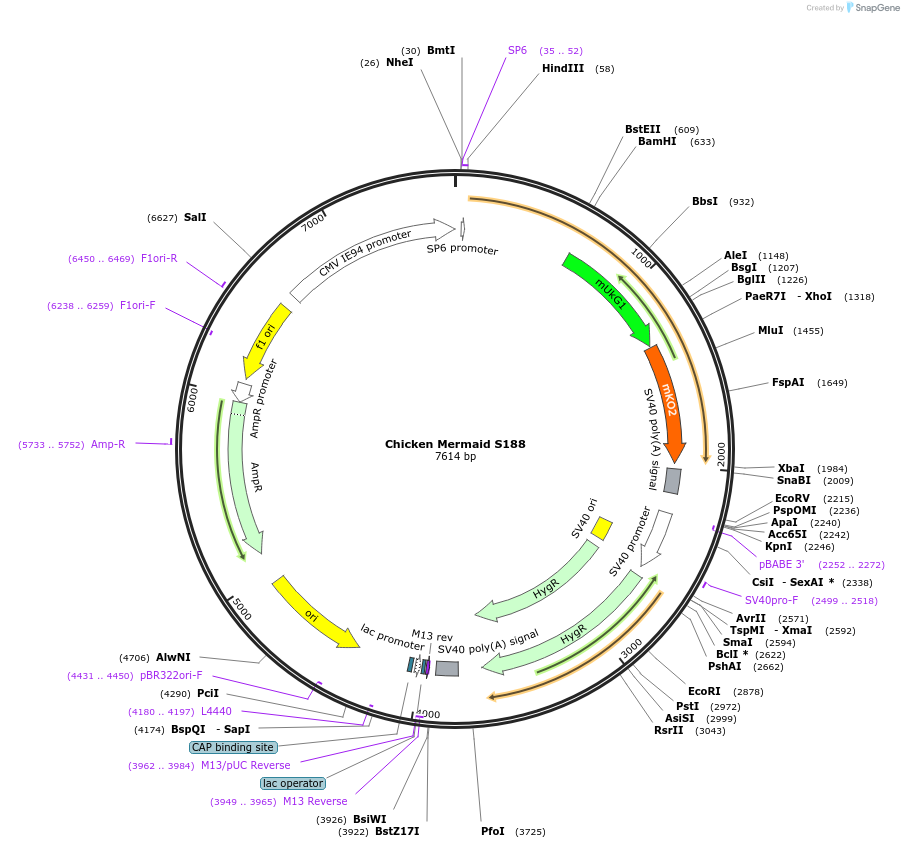-
PurposeGenetically encoded voltage sensor based on mUKG-mKOk FRET pair
-
Depositing Lab
-
Sequence Information
Ordering
| Item | Catalog # | Description | Quantity | Price (USD) | |
|---|---|---|---|---|---|
| Plasmid | 53617 | Standard format: Plasmid sent in bacteria as agar stab | 1 | $89 | |
Backbone
-
Vector backbonepCS2+
- Backbone size w/o insert (bp) 5694
- Total vector size (bp) 7614
-
Vector typeMammalian Expression
-
Selectable markersHygromycin
Growth in Bacteria
-
Bacterial Resistance(s)Ampicillin, 100 μg/mL
-
Growth Temperature37°C
-
Growth Strain(s)Top10
-
Copy numberHigh Copy
Gene/Insert
-
Gene/Insert nameChicken Mermaid S188
-
Alt nameGg-VSD Mermaid S188
-
SpeciesG. gallus (chicken), Synthetic
-
Insert Size (bp)1920
-
MutationGg-VSP contains an R153Q mutation and an amino acid E (GAG) was introduced immediately after the start M (ATG); Gg-VSP is truncated at S189 (S188 in the native Gg-VSP sequence) and the FRET fluorescent protein pair from the voltage probe Mermaid is fused to the C-terminal (after S189).
-
GenBank IDXP_417079.2
- Promoter CMV
Cloning Information
- Cloning method Restriction Enzyme
- 5′ cloning site HindIII (not destroyed)
- 3′ cloning site BamHI (not destroyed)
- 5′ sequencing primer AGCTGTATGAGAATGCGGTTGC
- 3′ sequencing primer ATGTCCCTCGTAAGGTCTGCCTGTGC
- (Common Sequencing Primers)
Resource Information
-
A portion of this plasmid was derived from a plasmid made byThe FRET pair present in this probe was derived from the Mermaid voltage sensor (Tsutsui et al., 2008). Tsutsui H, Karasawa S, Okamura Y, Miyawaki A. Improving membrane voltage measurements using FRET with new fluorescent proteins. Nat Methods 5: 683–685, 2008.
-
Articles Citing this Plasmid
Terms and Licenses
-
Academic/Nonprofit Terms
-
Industry Terms
- Not Available to Industry
Trademarks:
- Zeocin® is an InvivoGen trademark.
Depositor Comments
The chicken voltage sensitive phosphatase (VSP) sequence used in this construct contains an E14K mutation, when compared to the reference sequence XP_417079.2. This mutation could be polymorphism at the site or a PCR error. The depositing laboratory states that the plasmid functions as described in the associated publication.
These plasmids were created by your colleagues. Please acknowledge the Principal Investigator, cite the article in which the plasmids were described, and include Addgene in the Materials and Methods of your future publications.
-
For your Materials & Methods section:
Chicken Mermaid S188 was a gift from Vincent Pieribone (Addgene plasmid # 53617 ; http://n2t.net/addgene:53617 ; RRID:Addgene_53617) -
For your References section:
Fluorescent protein voltage probes derived from ArcLight that respond to membrane voltage changes with fast kinetics. Han Z, Jin L, Platisa J, Cohen LB, Baker BJ, Pieribone VA. PLoS One. 2013 Nov 27;8(11):e81295. doi: 10.1371/journal.pone.0081295. eCollection 2013. 10.1371/journal.pone.0081295 PubMed 24312287







